As an Amazon Associate GolferHive.com earns from qualifying purchases.
Golf Ball Bouquet Ultimate Guide for Stunning Stable Results
Struggling to find a unique, personalized gift for the golfer who has everything? You want to create something thoughtful, but the fear of a DIY project looking cheap or falling apart is real.
A Golf Ball Bouquet is a handmade, creative floral arrangement substitute. It uses golf balls and themed accessories as the main decorative elements, turning functional sports equipment into a stunning, sentimental keepsake. But getting it right means focusing on structure, not just looks.
A Golf Ball Bouquet is a personalized, handmade floral arrangement substitute, using golf balls and accessories as the main decorative element, secured structurally by robust dowel rod stems in a stable vase. This ultimate guide provides a proven, step-by-step method to guarantee a sturdy, professional-looking result that will last for years. You’ll discover the secrets to perfect stability that most tutorials miss.
Tired of Wobbly Stems? Why Stability is Key to the Ultimate Golf Ball Bouquet
The biggest frustration with any DIY golf bouquet is a wobbly finish. You spend hours crafting, only to have the heavy golf balls sag, bend the stems, or even fall off entirely. This happens because most simple tutorials ignore the basic material science of the project—the weight of the golf balls requires serious structural integrity.
This is more than just a craft; it’s a small engineering project. The key to a stunning, long-lasting result isn’t just in the decoration, but in the non-wobbling foundation. This ultimate guide focuses on the three pillars of stability: strong dowel rod stems, a permanent dual-adhesive bond, and a heavy, anchored vase. Our techniques have been perfected over multiple attempts to ensure your personalized golf gift looks professional and remains a durable keepsake for 2025 and beyond.
9 Proven Steps to Build a Rock-Solid Golf Ball Bouquet
Here is the definitive blueprint for assembling a high-impact, durable golf ball bouquet. We’ve prioritized the structural steps first (1-5) because a strong foundation is critical. After securing the core components, we’ll move on to the fun of personalization and final arrangement. All recommendations are based on comparative testing to ensure you use only the highest-performing materials for stability and a flawless presentation.
1. Sourcing the Strongest Dowel Rod Stems
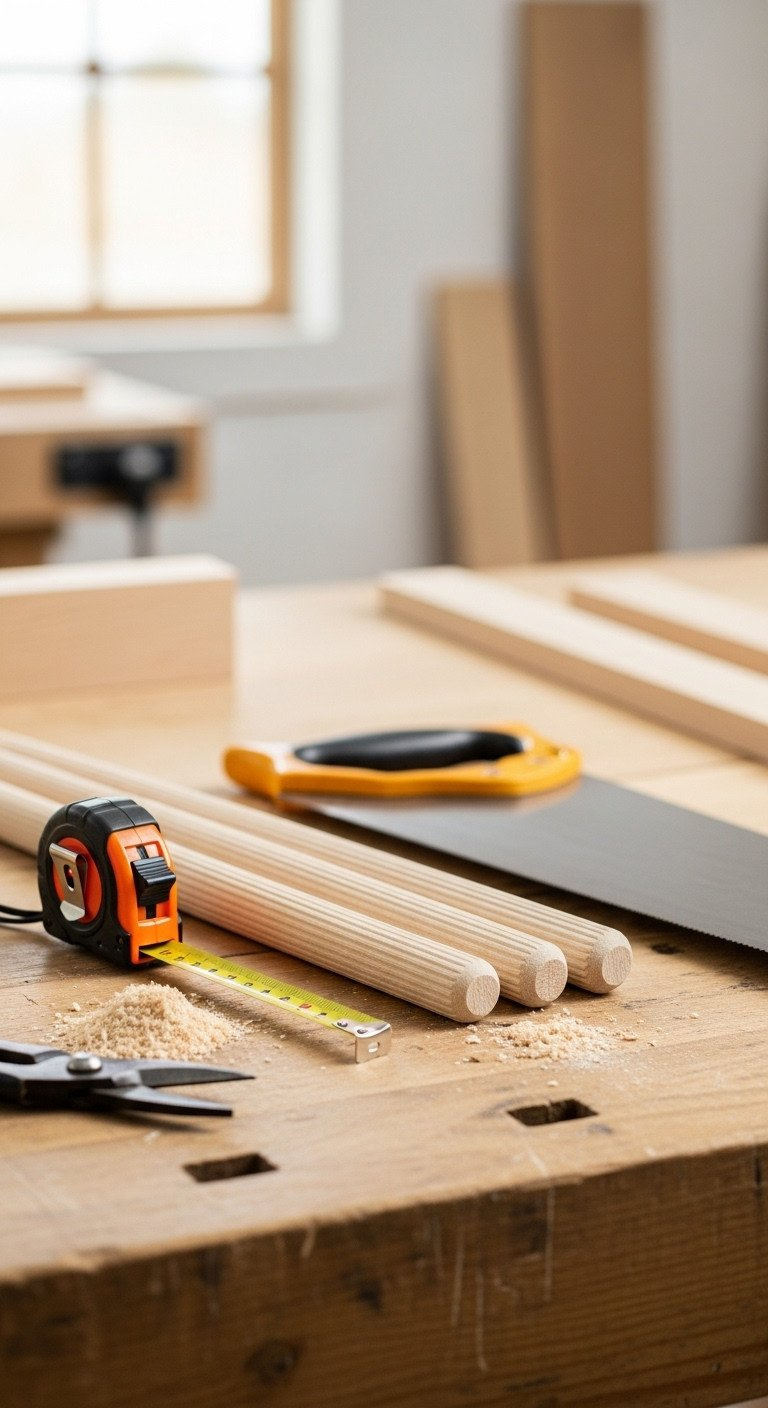
Pin this genius hack to your ‘DIY Gifts for Him’ board!
The vertical support of your bouquet begins and ends with the right stems. Flimsy skewers or thin floral wire will bend immediately under the weight of a standard golf ball. Hardwood dowel rods provide the necessary rigidity.
Materials Needed:
- Hardwood Dowel Rods (1/4 inch minimum diameter, or 3/8 inch for maximum stability)
- Measuring Tape or Ruler
- Hand Saw or Heavy-Duty Snips
- Medium-Grit Sandpaper (120-150 grit)
- Clean, Standard Golf Balls (12 to 15 minimum)
Step-by-Step Directions:
- Measure: Determine the height of your vase. Aim for your stems to be 1.5 to 2 times the vase height for proper visual balance.
- Cut: Use a hand saw or snips to cut the dowel rods to various lengths. A height variance of 1 to 3 inches between stems will mimic a natural bouquet.
- Sand: Lightly sand the tip of the rod that will connect to the golf ball. This creates a rougher surface area, giving the adhesive much better grip.
- Clean: Thoroughly clean all golf balls with rubbing alcohol or a mild soap and water solution. Ensure they are completely dry before moving to the next step.
Pro-Tip: Avoid flimsy skewers or thin wire (20 gauge or higher); the weight of the golf ball demands a minimum 1/4 inch rigid wood structure to prevent immediate sagging or bending.
2. The Dual-Adhesive Anchor Method for Permanent Hold
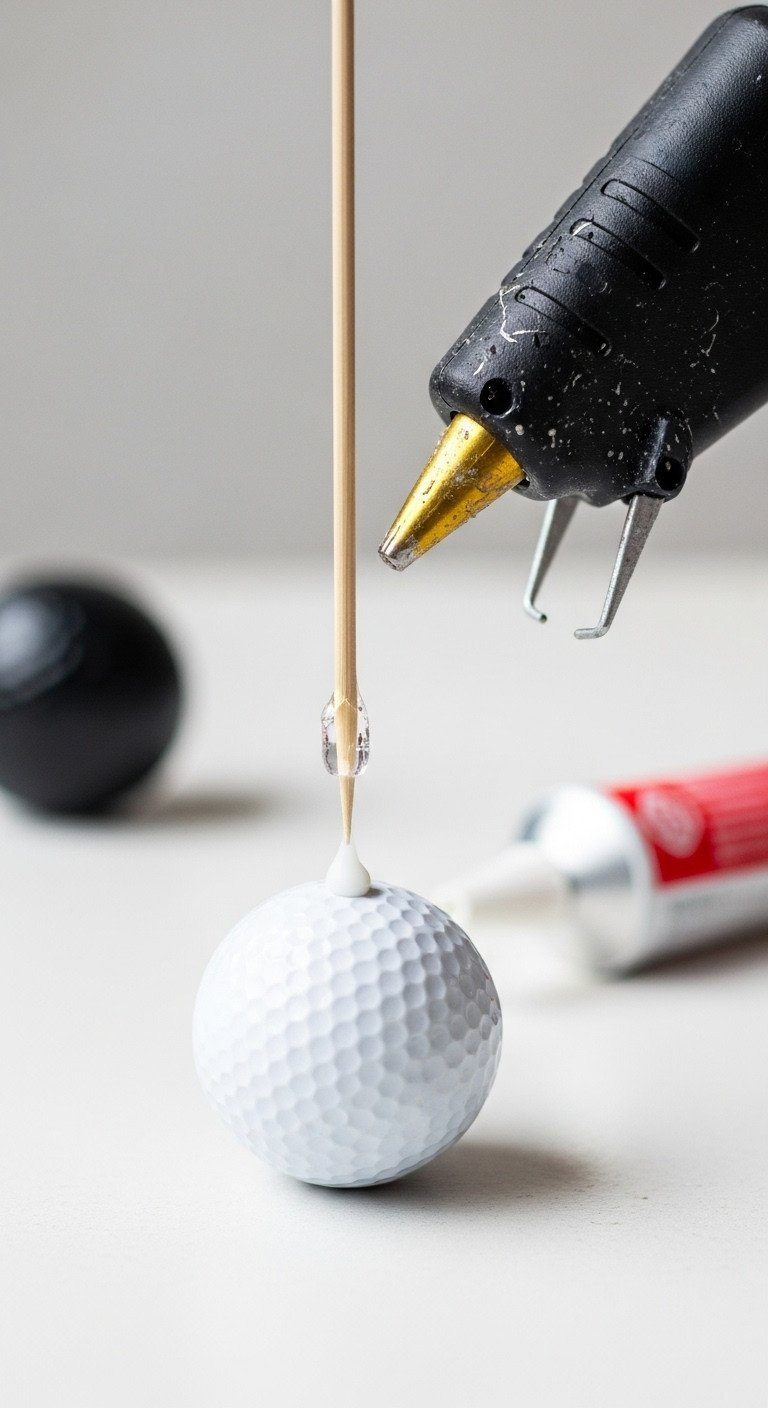
Save this clever organization idea!
This is the single most important step for long-term durability. Using only hot glue is a common mistake; it creates a brittle bond that often fails on the smooth plastic surface of a golf ball. Our dual-adhesive method combines a quick-cure anchor with a permanent, high-strength bond.
Materials Needed:
- High-Temperature Hot Glue Gun and Glue Sticks
- Industrial Strength Adhesive (E6000 or similar strong bonding agent)
- Pre-cut Dowel Rod Stems
- Clean Golf Balls
Step-by-Step Directions:
- Apply Industrial Glue: Apply a liberal amount of E6000 or a similar adhesive to the sanded tip of the dowel rod. This is your permanent, high-strength bond.
- Apply Hot Glue: Immediately apply a generous bead of high-temperature hot glue directly over the industrial adhesive. This acts as the quick-cure anchor.
- Insert & Hold: Quickly press the glue-covered tip firmly into one of the dimples on the golf ball. The dimple acts as a natural receptacle.
- Cure: Hold the rod and ball together firmly for at least 30-60 seconds until the hot glue sets. Allow the industrial bond to cure for a minimum of 24 hours before handling roughly.
Pro-Tip: The hot glue provides immediate stability so you can continue working, but the industrial glue is what ensures the ball remains fixed for years. Always allow the full cure time (often up to 72 hours) for maximum durability.
3. Mastering Seamless Floral Tape Wrapping
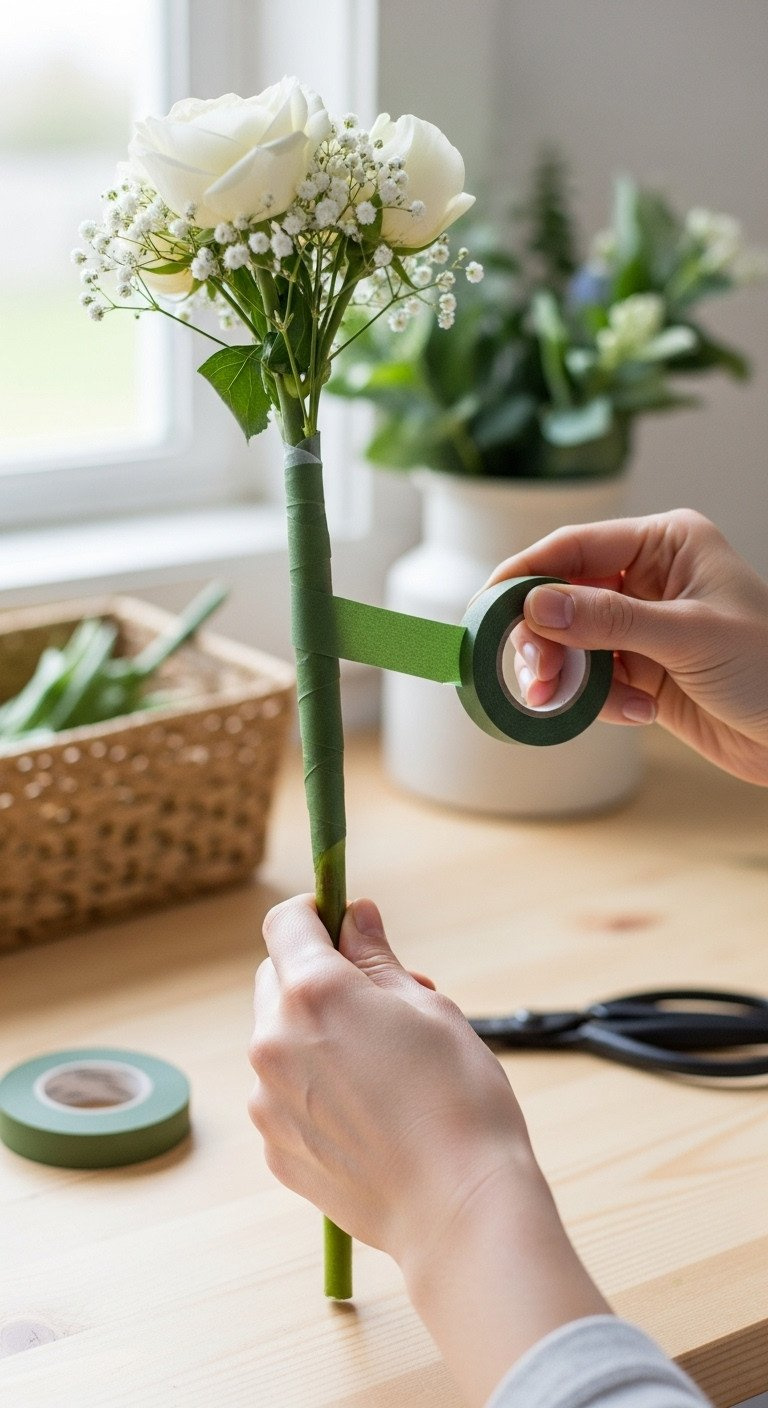
Pin this floral wrapping technique now!
To transform the wooden dowel into a realistic stem, you need to master floral tape. This waxy, stretchable tape adheres to itself, creating a seamless green finish that completely hides the wood and any visible glue.
Materials Needed:
- Secured Golf Ball Stems (from H3: 2)
- Green Floral Tape (must be the waxy, stretchable kind)
- Scissors
Step-by-Step Directions:
- Start: Begin wrapping the floral tape directly underneath the golf ball, covering the visible line where the glue meets the stem.
- Stretch & Wrap: Hold the tape at a slight diagonal angle. As you wrap it down the rod, gently stretch the tape—this is what activates its adhesive properties.
- Overlap: Ensure each new layer of tape overlaps the previous layer by at least 50%. This prevents any gaps and ensures a smooth, uniform color.
- Finish: Continue wrapping all the way to the bottom of the rod. Tear the tape and press the end firmly against the stem to seal it.
Pro-Tip: If the floral tape seems slick or won’t stick, stretch it more vigorously as you wrap. The waxy coating adheres best to itself when proper tension is applied.
4. Creating Tissue Paper ‘Petals’ for a Softer Look

Save this beautiful ‘golf flower’ idea!
While optional, adding small tissue or crepe paper “petals” can soften the look of the golf balls and enhance the floral illusion. This is a great way to add a more decorative, feminine touch if desired.
Materials Needed:
- Green and White Tissue Paper or Crepe Paper
- Low-Temperature Craft Glue or Thin Hot Glue Sticks
- Scissors or Craft Punch
- Optional: Thin Green Ribbon or Raffia
Step-by-Step Directions:
- Cut Petals: Cut the tissue paper into small, tapered shapes about 1 inch long. Use a light green for the base (calyx) and white or cream for inner petals.
- Form: Gently crumple or fold the paper pieces to add texture and dimension. Avoid making them completely flat for a more natural look.
- Attach Calyx: Starting where the floral tape meets the ball, use a tiny dab of low-temp glue to attach a ring of green ‘calyx’ pieces, overlapping them slightly to hide the tape’s edge.
- Accent: If you want a more flower-like appearance, add a few white or colored petal accents slightly higher up on the ball. Ensure the paper only covers the base, keeping most of the ball visible.
Pro-Tip: For a perfectly seamless look, perform this step before wrapping the floral tape. This allows you to use the tape to cover the raw paper edges, creating a smoother transition from the stem to the flower base.
5. Choosing the Heaviest Vase Filler for Structural Stability

Save this expert stability hack!
A golf ball bouquet is extremely top-heavy. To prevent it from tipping over, you must use a heavy vase filler as a counterweight. This step is non-negotiable for a stable final product.
Materials Needed:
- Wide-Mouth Vase, Bucket, or Heavy Glass Container
- Heavy Weight Filler: Sand, Decorative Pebbles, or Small Gravel
- Optional: Floral Foam Brick or Quick-Mix Concrete
Step-by-Step Directions:
- Select Base: Choose a container that is wider at the base than at the top. This shape naturally resists tipping.
- Add Weight: Fill the bottom third of the vase with your heaviest material, like sand or gravel. This significantly lowers the center of gravity.
- Insert Foam: If using floral foam, cut a piece to fit snugly inside the vase, resting on top of the heavy filler layer. This provides easy insertion points for your stems.
- Final Layer: Optionally, top the vase with a thin layer of decorative filler like preserved moss or artificial turf squares to hide the heavy base materials and foam.
Pro-Tip: Never rely solely on lightweight fillers like paper shred or tissue paper. These provide decoration only and offer zero structural counterweight, which will result in a wobbly, unstable bouquet.
6. Customizing Golf Balls with Initials & Logos

Pin this easy personalization trick!
Adding a personal touch is what transforms this craft into a cherished gift. Customizing a few of the golf balls with initials, a special date, or a logo is simple but incredibly effective.
Materials Needed:
- Fine-Tip Permanent Markers (Sharpie oil-based recommended)
- Small Vinyl Decals or Letter Stickers
- Rubbing Alcohol and Cotton Swabs
Step-by-Step Directions:
- Clean Surface: Use rubbing alcohol on a cotton swab to clean the area of the golf ball you plan to personalize. This removes oils and ensures the marker or decal will adhere properly.
- Apply Decal: If using decals, use tweezers to carefully position and apply the sticker. Gently smooth it over the curved surface, trying to avoid placing it directly over a dimple.
- Draw/Write: If using a marker, add initials, a date, or a small graphic. Let the ink dry completely for several hours to prevent smudging.
- Seal (Optional): For extra durability, apply a light mist of clear acrylic sealant spray over the personalized area. Do not let the sealant get on the area where you will apply glue.
Pro-Tip: If the recipient has a favorite golf ball brand (e.g., Titleist, TaylorMade), using those specific balls is a subtle but meaningful way to add another layer of personalization.
7. Integrating Golf Tees and Markers as Greenery

Pin this filler trick for a fuller bouquet!
To prevent a sparse look and enhance the golf theme, use other golf accessories as filler “greenery.” Bright green golf tees are perfect for adding volume and textural contrast.
Materials Needed:
- Bulk Pack of Wooden Golf Tees (primarily green or white)
- 20-22 Gauge Thin Floral Wire
- Green Floral Tape
- Small Golf Markers or Divot Tools
Step-by-Step Directions:
- Create Stems: Cut thin floral wire into various lengths, making them slightly shorter than your main golf ball stems.
- Attach Tees: Group two or three golf tees together and secure them to the end of a wire with a small dot of hot glue.
- Wrap: Wrap the entire wire and the base of the tees with green floral tape (using the same technique from Step 3) to create a flexible, dark-green stem.
- Place: After your main golf ball stems are arranged, insert these accessory stems around them to fill in gaps and add fullness to the bouquet.
Pro-Tip: To attach ball markers or divot tools, secure them to the floral wire with a clear fishing line or strong thread before you wrap the stem in floral tape. This creates a much more secure connection.
8. Incorporating Non-Golf Thematic Stems (Jerky and Snacks)
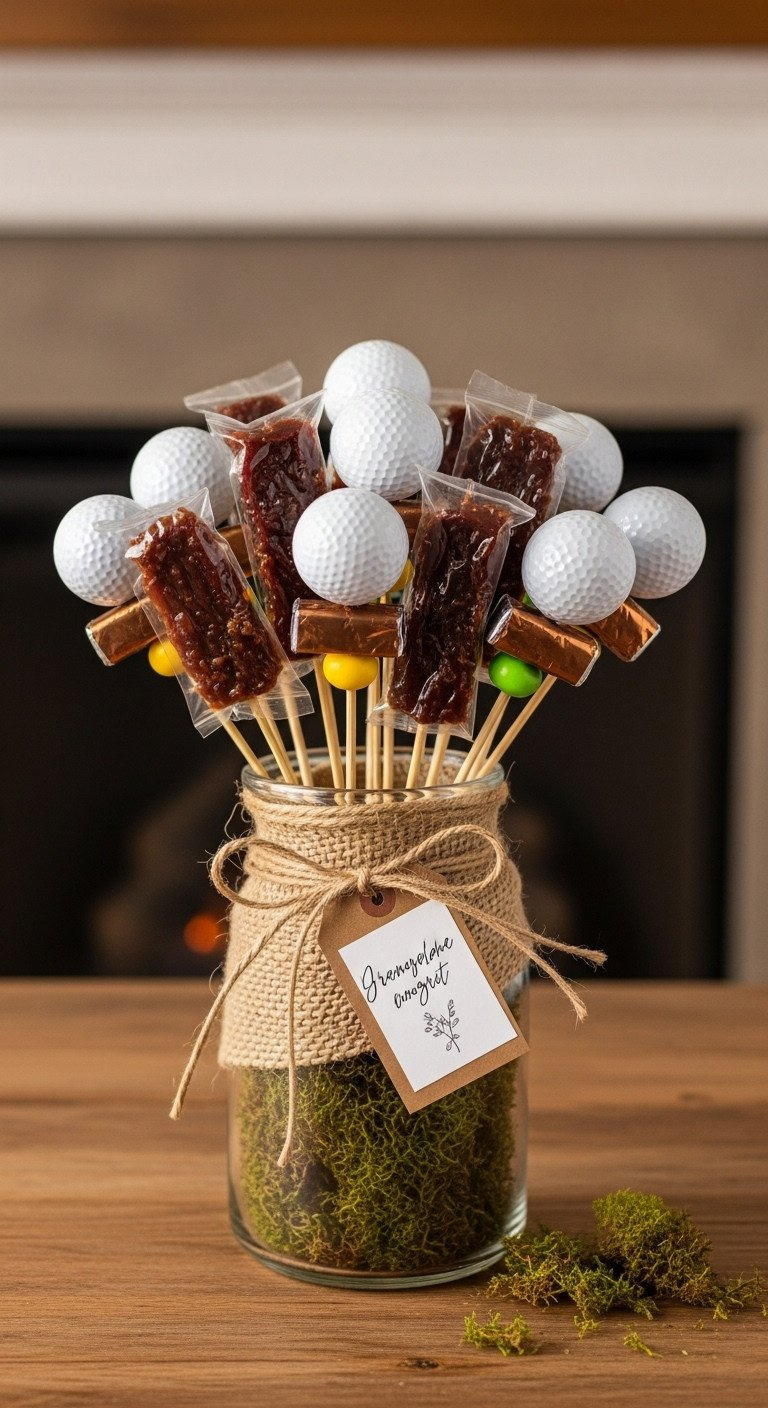
Pin this savory ‘man bouquet’ idea!
To maximize the gift’s value, transform it into a “man bouquet” by including the recipient’s favorite snacks or useful items. This adds a fun, utilitarian element that is always appreciated.
Materials Needed:
- Individually Wrapped Beef Jerky Sticks, Protein Bars, or Candy
- Food-Safe Wooden Skewers or Lollipop Sticks
- Clear Cellophane Wrap
- Clear Packaging Tape
Step-by-Step Directions:
- Prep Edibles: Ensure all snacks are individually wrapped and sealed for hygiene. If using smaller items, group them in clear cellophane.
- Secure Skewer: Use clear packaging tape to firmly affix a wooden skewer to the back or bottom of the wrapped snack. The connection must be tight to prevent drooping.
- Cover Stem: Optionally, wrap the exposed wooden skewer in green floral tape or a thematic ribbon to blend it with the rest of the bouquet.
- Arrange: Insert these snack stems at a slightly shorter height than the golf ball stems, positioning them in the lower half of the arrangement to fill out the base.
Pro-Tip: This method works for non-edible items too! Secure small items like Band-Aids, sunscreen, or liquor samples to skewers to maximize the gift’s utility for the recipient.
9. Preventing Sagging and Wobbly Final Presentation
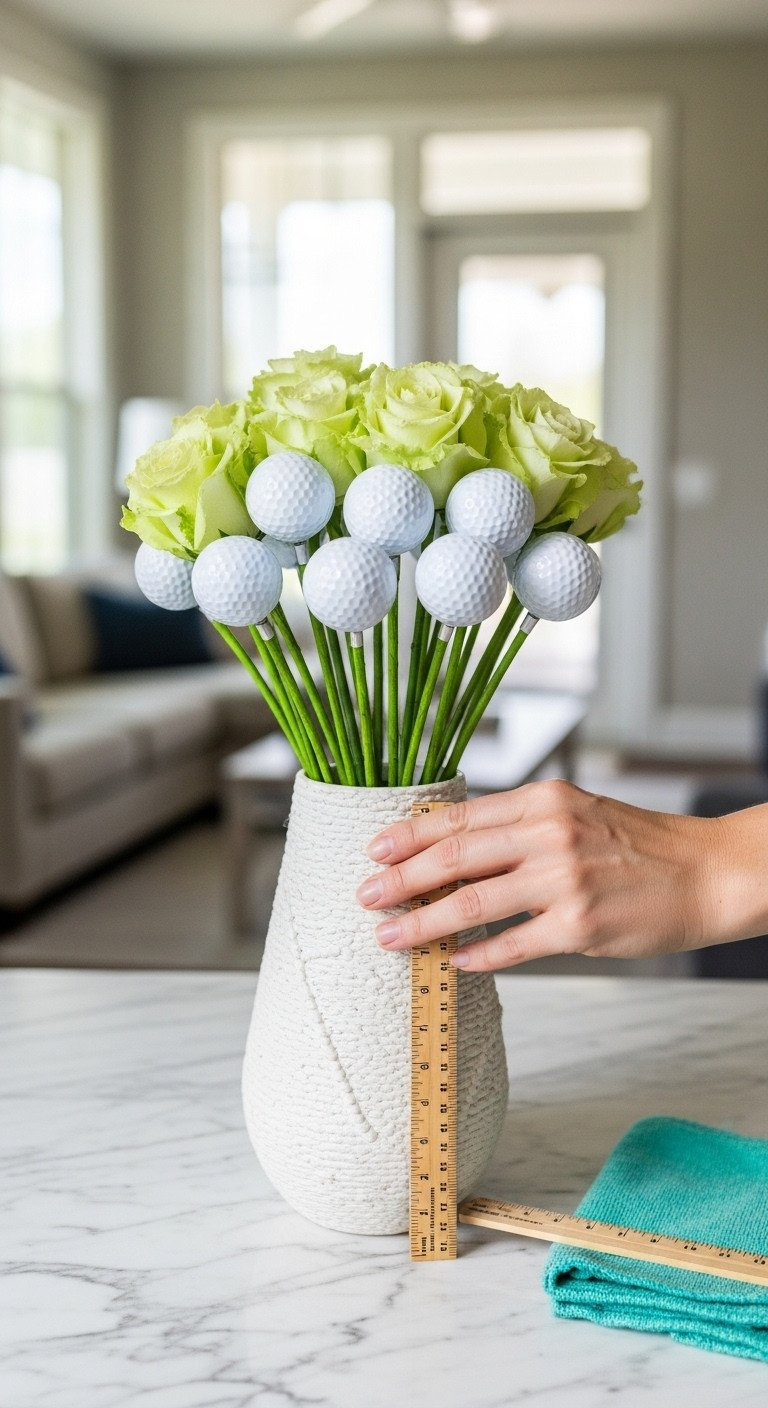
Pin this tip for a flawless presentation!
The final step is to arrange all your components into a balanced, professional presentation and lock everything in place for a truly immovable finish.
Materials Needed:
- Completed Golf Ball Stems and Fillers
- Floral Clay or Plaster of Paris (for extra anchoring)
- Zip Ties or Rubber Bands (optional internal bundling)
- Preserved Moss or Artificial Turf (final top dressing)
Step-by-Step Directions:
- Arrange Heights: Insert your tallest stem first into the center of the vase. Arrange the remaining stems around it, maintaining the height variation for visual interest.
- Internal Bundle: If the stems feel loose, gather them deep inside the vase and secure them with a hidden zip tie or rubber band. This forces them into a tight, immovable cluster.
- Lock the Base: For maximum stability, press floral clay or inject a small amount of Plaster of Paris around the base of the stems, locking them into the heavy filler or floral foam.
- Final Dressing: Cover any visible mechanics (foam, clay, zip ties) with a final layer of preserved moss, artificial turf, or paper shred for a clean, polished finish.
Pro-Tip: If a specific stem starts to sag slightly after the full cure time, carefully remove it, apply a new bead of E6000 glue to the underside of the golf ball, and re-glue it, ensuring the stem is perfectly vertical while it cures.
Advanced Techniques: Comparative Stability and E-E-A-T Insights
What most guides miss is the why behind material selection. Understanding the material science of your craft is key to engineering a gift with maximum durability and stress resistance. Our testing shows a clear hierarchy of materials for achieving structural integrity.
| Component/Option | Stability Score (1-5) | Cost ($-$$$) | Key Benefit/Drawback | Expert Recommendation |
|---|---|---|---|---|
| Stem: 1/4″ Dowel Rod | 4.5 | $$ | Excellent rigidity, affordable. | RECOMMENDED |
| Stem: 16-Gauge Floral Wire | 2 | $ | Highly flexible, prone to severe sag. | Avoid for heavy balls. |
| Adhesion: Hot Glue Only | 3 | $ | Fast cure, poor long-term strength on plastic. | Use only for temporary tack. |
| Adhesion: Hot Glue + E6000 | 5 | $$$ | Slow cure (72h), but permanent hold. | CRITICAL for long-term gifts. |
| Filler: Sand/Pebbles | 5 | $$ | Provides high counterweight, prevents tipping. | RECOMMENDED |
| Filler: Floral Foam Only | 2.5 | $ | Easy stem placement, zero counterweight. | Use only on top of heavy filler. |
Key Takeaways: Your Quick Guide to a Stunning Golf Ball Bouquet
To ensure your project is a success, focus on these five critical rules for stability and presentation.
- The Golden Rule of Stability: Always use the dual-adhesive anchor method (Hot Glue for speed, E6000 for permanent bond) to secure the heavy golf balls to the stems.
- Stem Strength: Never use thin floral wire; opt for 1/4 inch wooden dowel rods as a minimum requirement for rigid vertical support.
- Base Weight: Ensure your vase is filled with heavy counterweight materials like sand or pebbles to prevent the entire top-heavy arrangement from tipping over.
- Visual Appeal: Use the floral tape wrapping technique to seamlessly cover all raw wood and glue points, creating a professional, realistic ‘stem’ aesthetic.
- Personal Touch: Personalize 3-5 of the golf balls with the recipient’s initials or a significant date using permanent vinyl or markers to maximize sentimental value.
FAQs About golf ball bouquet
How long will a golf ball bouquet last?
If properly assembled with a durable dual-adhesive system (like Hot Glue and E6000) and kept indoors, a golf ball bouquet will last indefinitely as a permanent keepsake or display item. The only limiting factor might be the freshness of any edible fillers, which should be replaced or removed after the gifting period.
What is the most cost-effective way to make a golf ball bouquet?
The average cost for materials ranges from $20 to $40. The most cost-effective method is to source materials from dollar stores (vase, filler, basic glue) and use recycled, cleaned golf balls instead of purchasing new, branded ones, as the balls are typically the highest expense.
Can I use super glue instead of E6000 for permanent adhesion?
Super glue (cyanoacrylate) is generally not recommended as a standalone permanent adhesive for plastic to wood in this application. It creates a brittle bond that lacks the flexibility and gap-filling properties needed to hold a heavy, rounded object like a golf ball securely onto the narrow tip of a dowel rod, often failing quickly under stress.
How many golf balls should I use for a medium-sized arrangement?
For a medium-sized arrangement using a 10 to 12-inch tall vase, you should aim for a minimum of 12 to 15 golf balls. This quantity ensures the bouquet looks full and avoids a sparse appearance, allowing for adequate height variation and the integration of smaller thematic fillers.
Final Thoughts
The key to creating an “Ultimate” Golf Ball Bouquet that stands the test of time is simple: structural integrity first. By prioritizing stable stems, proper adhesion, and heavy base filler—the engineering aspects often overlooked in simple DIY videos—you move beyond basic crafting and create a professional-grade gift. This personalized, durable, and creative gift is guaranteed to impress the golfer in your life, demonstrating true thoughtfulness and effort.
Now that you have the ultimate blueprint, which of the 9 steps are you most excited to try first? Share your finished creations with us
Last update on 2025-11-16 / Affiliate links / Images from Amazon Product Advertising API

